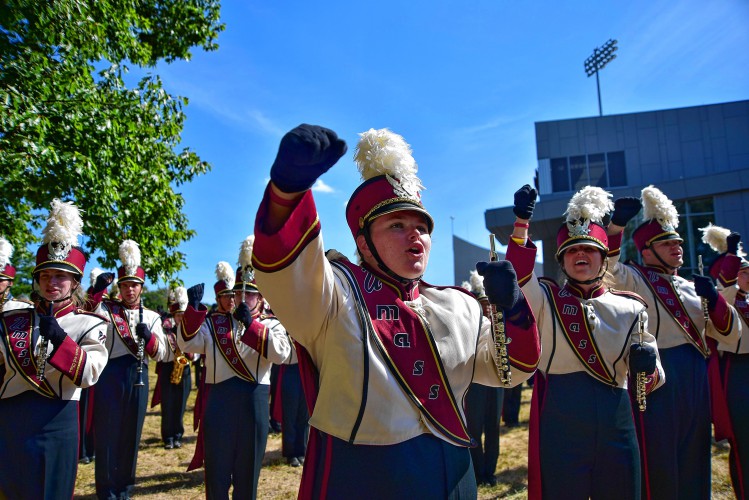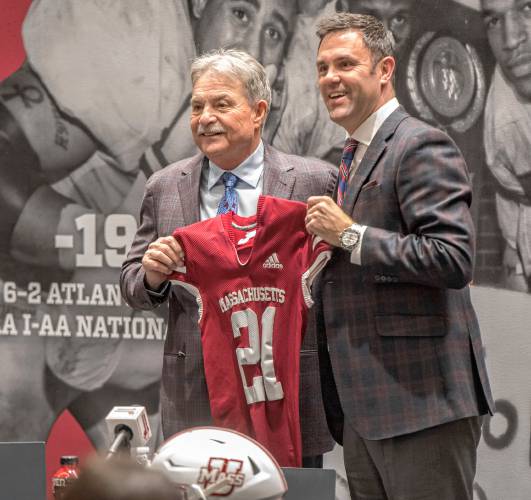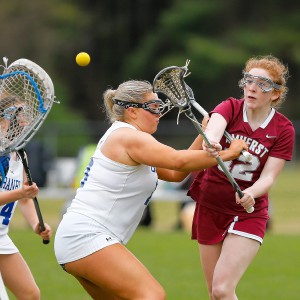Fan base conflicted on UMass’ decision to leave Atlantic 10, move to the MAC
| Published: 02-27-2024 2:38 PM |
News that’s been imminent for months finally broke Monday afternoon — UMass is leaving the Atlantic 10 Conference and joining the MAC.
And while finding a conference home for the school’s football program has been at the forefront of conversation for some time, the realization that it is, in fact, happening was met with differing opinions throughout the UMass sporting community.
At the crux of the issue, the response is pretty simple: if you’re a UMass football fan, you’re probably happy. If you’re a die-hard basketball fan, you probably aren’t.
It was always going to be this way. Differing viewpoints within the same institution, factions looking out for the best interest of their respective revenue-generating sport.
Football fans knowing the long-term success of the program is tied to finding a conference home, and the stability that comes with television revenue, bowl tie-ins, a guaranteed schedule that won’t require mountains to be moved each offseason.
Basketball fans knowing the fallout that’s to come, how leaving the eighth best conference in the country to play in the 24th best conference in the country is a decided step backward. How recruiting players to the MAC, and scheduling non-conference opponents to play at the Mullins Center will become even more difficult than it already is.
In the end, conference realignment surrounding the University of Massachusetts was never an open and shut case. There was no perfect solution, unless the Big Ten ever came calling, and no matter what decision the university made, one section of the fan base was ultimately going to be unhappy.
That’s college athletics in 2024. It’s a world where many think they see the future, think they can predict what is best against an ever-evolving landscape. But at the end of the day, your best hope is a willingness to be aggressive, to make a move with a purpose, and back that decision with resources and institutional support.
Article continues after...
Yesterday's Most Read Articles
That appears to be exactly with UMass is doing.
There are valid arguments from both sides here. It’s reasonable to think the football program wouldn’t survive long term as an independent. With UMass joining the MAC, just two programs remain as FBS independents – Notre Dame and UConn. An independent path without a conference is no longer viable in the current landscape of realignment, with an expanding College Football Playoff and power leagues growing in size. So while the MAC might not be the preferred destination (and ideally not the final destination) it was a conference willing to take UMass – for a second time.
It’s also reasonable to think that the basketball programs will be considerably worse off as a result of this move. As mentioned before, the MAC ranks No. 24 out of 33 men’s basketball conferences in the country according to KenPom. The A-10 sits at No. 8.
In terms of NCAA Tournament bids, the A-10 has put 156 teams in the Big Dance in its history compared to 64 for the MAC. Of those 156 bids, 90 are from schools currently in the league (Temple and Xavier were the top two schools in terms of bids, though both have since left for other conferences).
Using the current men’s basketball season as a guide, the MAC has just one top 100 KenPom team (Akron, No. 97), and eight of the league’s 12 teams are ranked 200th or worse. In comparison, the Atlantic 10 has seven teams in the top 100 (including UMass at No. 90), and just two teams ranked 200th or worse.
Those numbers aren’t great, but what exactly will the Atlantic 10 Conference look like in five years? In 10 years? Could the league be a poaching ground for other top conferences like the Big East? Powers like Dayton and VCU are prime candidates to move elsewhere, and they don’t have to worry about football in a potential conference realignment scenario.
There’s a lot to unpack, and the news is still being processed by UMass fans and alumni. While it’s impossible to predict exactly how this move will play out in the years to come, there is the hope that once the dust settles, the entire fan base will rally together and support the school – whether they agreed with the move or not. Now is the time for discourse and discussion, but once the 2025-26 academic year comes, UMass is going to be in the MAC – for better or worse.
Jeff Lajoie is a UMass alum and the sports editor of the Daily Hampshire Gazette and Greenfield Recorder. He can be reached at jlajoie@recorder.com



 Boys tennis: Sixth grader Lee Ferguson key cog in PVCICS’ win over Belchertown, undefeated start to the season (PHOTOS)
Boys tennis: Sixth grader Lee Ferguson key cog in PVCICS’ win over Belchertown, undefeated start to the season (PHOTOS) South Hadley boys volleyball team making strides in first season as program
South Hadley boys volleyball team making strides in first season as program 2024 Gazette Boys Swimmer of the Year: Luke Giguere, Belchertown
2024 Gazette Boys Swimmer of the Year: Luke Giguere, Belchertown Girls lacrosse: Amherst stays undefeated, runs away from Granby for second win in as many days (PHOTOS)
Girls lacrosse: Amherst stays undefeated, runs away from Granby for second win in as many days (PHOTOS)
